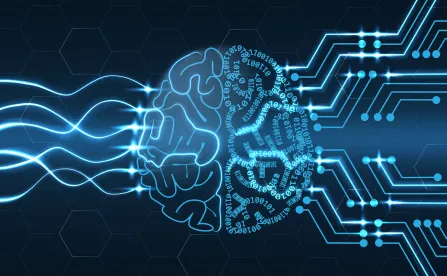Technology and medical companies around the world are rising to meet the challenges created by the COVID-19 pandemic, in many cases turning to artificial intelligence (“AI”) and super computers in their efforts to develop life-saving treatments for the disease as quickly as possible.1 In late March, the White House announced the launch of the COVID-19 High Performance Computing Consortium to bring together industry leaders in AI with national laboratories and academics to “significantly advance the pace of scientific discovery in the fight to stop the virus.”2 Google, a member of the Consortium, has shared computationally predicted structures of viral proteins generated by its AI platform on open access databases in an effort to speed up the process of identifying a vaccine.3 Further, the therapeutic company ImmunoPrecise announced it is using AI to develop immunotherapy for those who have the virus.4 In the wake of COVID-19, other industries are looking to AI for tracking, predictive modeling, diagnosis and prognosis.5 While the use of AI will undoubtedly bring tremendous innovation, the data, test results, and any inventions resulting from its use will also raise questions about how to best protect these innovations and who should get credit as an inventor.
Background
As a threshold issue, the question of inventorship is central to whether innovations by AI itself—as opposed to innovations where a human identifies a solution but utilizes AI to verify the results—are protectable under current U.S. patent law. “The requirement that the applicant for a patent be the inventor is a fundamental characteristic of U.S. patent law.”6 Pursuant to the America Invents Act (“AIA”), Congress has defined an “inventor” as “the individual, or if a joint invention, the individuals, collectively, who invented or discovered the subject matter of the invention.”7 As clarified by the Federal Circuit, an “inventor” is one who contributes to the “conception” of the complete and operational invention.8
The Federal Circuit has interpreted this statutory language to mean that an inventor must be human, seemingly precluding inventions by AI from patent protection. In particular, the Federal Circuit has expressly held that “only natural persons can be inventors.”9 This interpretation is consistent with the rule of statutory construction set forth in 1 U.S.C. § 8(a) which states “[i]n determining the meaning of any Act of Congress, or of any ruling, regulation, or interpretation of the various administrative bureaus and agencies of the United States, the words ‘persons,’ ‘human being,’ ‘child,’ and ‘individual,’ shall include every infant member of the species homo sapiens who is born alive at any stage of development.”10 Moreover, the Federal Circuit has interpreted “conception”—the touchstone of invention—as requiring the formation of thought “in the mind of the inventor,” which seemingly would exclude inanimate objects lacking minds.11
However, these interpretations preceded the era of AI-assisted research and development, leaving open arguments that the definition of “inventor” must be amended to account for this new paradigm. Indeed, one can envision scenarios where new inventions are created almost entirely by AI—including treatments for COVID-19—and no humans would qualify as inventors under the current standard. Under the literal application of U.S. patent law, such potentially life-saving inventions would likely not be protectable by patent, as patents are generally invalid unless they properly list inventors.12 Moreover, patent applications arising from AI-based innovations would likely be rejected by the United States Patent & Trademark Office (“USPTO”) for failure to identify inventors and submit all appropriate oath and declarations.13
Although the Federal Circuit has yet to directly address the situation where something other than a human invents, the Ninth Circuit recently discussed the question of who is an author under the copyright laws, which may be instructive. In Naruto v. Slater, the Ninth Circuit declined to hold that anything other than a human could have standing as an author under the copyright laws. At the district court level, People for the Ethical Treatment of Animals (“PETA”) sued a camera owner for copyright infringement on behalf of a primate, arguing that because the primate had taken photographs of itself with the camera owner’s camera, it was the rightful copyright owner under the Copyright Act. While opining on the statutory standing of the selfie-taking primate, the Ninth Circuit looked to the definition of an author in the Copyright Act to see if there were any hints suggesting whether an author must be a human.14 After noting the statute’s references to an author’s children and widow, the Ninth Circuit found that humanity was a necessary component and held that “all animals, since they are not human[,] lack statutory standing under the Copyright Act.”15 The decision sidesteps the question of whether a nonhuman can be an author, but suggests that it cannot.
Recognizing the problem it faces, the USPTO has asked for comments from the public as to how to deal with inventions created with AI.16 Numerous individuals and organizations, including legal associations and technology companies, submitted responses stating their own view on the issue.17 However, there is currently no official statement from the USPTO about any policy changes.
Lessons From Abroad
The question of whether AI can ever properly be an inventor is not unique to the United States. The European Patent Office (“EPO”) and the UK Intellectual Property Office (“UKIPO”) recently confronted this issue when the first patent application for an invention developed entirely by AI was filed last year by a team from the University of Surrey. The inventor was listed as “DABUS,” an AI created by Stephen Thaler. The team heavily advocated for artificial intelligence to be named as inventors during the patent application process. They argued that allowing AI to be listed as an inventor would promote the development and use of AI in scientific discoveries. However, both the EPO and the UKIPO rejected this policy argument by denying the application, stating an inventor must be a human.18
Patent offices in Asia appear to be more lenient when it comes to AI inventors. The Japanese Patent Act and the Korean Patent Act do not include an explicit definition of an inventor, and the Chinese State Council has called for better intellectual property protections to promote AI.19 Seemingly in correlation to its efforts to increase AI patent protection, China has seen an increase in the number of AI-related patent filings and now has more than double the amount of AI-related patent applications than the United States.20 Without Congressional action to protect AI inventions in the United States, the more flexible approaches of such foreign countries may incentivize innovators to move their industry to countries in which their intellectual property will receive stronger protection.
Other Possible Solutions
While allowing AI to be named as an inventor may turn out to be a nonviable solution for a number of political and logistical reasons, one approach Congress could consider would be to amend the patent laws to permit a corporate entity to be named as the inventor. Under current U.S. law, companies may not be listed as an inventor, but may be assigned patent rights. However, the ability to name a corporate entity as an inventor might provide the flexibility needed to address the unique issues presented by discovery through AI—where the inventor is not solely a human. While such a system potentially raises other issues, including what happens in the case where one company owns the AI, but another implements it in a manner leading to the claimed invention, these problems can be mitigated by solutions available under current laws, such as joint inventorship, and by adjudication in U.S. courts. Another possibility is to allow the human programmer of the AI or the human that defined the task for the AI program to be recognized as the named inventor. Congress has many options to consider, but the question of whether AI may be an inventor remains theirs to answer. The COVID-19 pandemic, and the search for effective therapeutics and an eventual vaccine, may just be the situation that spurs Congress to take action.
Recommendations For Protecting AI-Based Inventions Using Current Law
Strong patent protection afforded by the U.S. patent system has always been critical to America’s success as the technology and innovation leader of the industrialized world. Until the patent laws reflect the new reality in which we live—where many of our modern problems are being solved by the immense processing power of machines—companies who are using AI to develop new technologies, including new treatments for COVID-19 and other diseases, will need to protect their discoveries in other ways, such as through contracts or trade secrets.
Trade Secrets
The Defend Trade Secrets Act (“DTSA”) provides a way for companies to mitigate the uncertainty as to whether AI inventions are protectable under the current patent laws. The DTSA provides a federal cause of action allowing for injunctive relief, money damages, and, in extraordinary circumstances, ex parte seizure of property when “necessary to prevent the propagation or dissemination of the trade secret that is the subject of the action.” The DTSA broadly defines trade secrets as “all forms and types of financial, business, scientific, technical, economic, or engineering information[.]”21 This has been found to include many types of discoveries, test results, and data generated in the pursuit of scientific know-how.22 Thus, many companies will likely turn to trade secrets to protect inventions, discoveries, test results, and data derived using AI programs. Trade secrets have proven to be an effective way to protect achievements outside the typical intellectual property statutes and may serve an even more important role with the new AI technology.
Contracts
In the midst of the uncertainty surrounding patent protection for AI generated inventions, companies need to be vigilant regarding contractual language in order to protect any IP rights that may exist. In drafting contracts, companies should include language that specifies who will own any data, test results or discoveries made using AI programs and that clearly identifies these types of things as trade secrets. Any language crafted should also consider ownership rights based on whether the AI was developed in-house or created by a third party to prevent any dispute later on.
As technology advances and reliance on AI continues to grow, Congress will need to address the issue of whether the definition of an inventor should be limited to humans and whether AI-derived inventions can be protected by the patent system at all. Ultimately, without intervention from Congress, an invention that is the product of AI would likely succumb to a challenge of unpatentability or invalidity based on the lack of a human inventor. In the meantime, companies who are trail blazing the AI innovation path should consider employing trade secrets and carefully crafted contract language to protect any data, test results or inventions resulting from the use of AI.
1 See Bernard Marr, Coronavirus: How Artificial Intelligence, Data Science and Technology is Used to Fight the Pandemic, Forbes (Mar. 13, 2020 1:57 am) https://www.forbes.com/sites/bernardmarr/2020/03/13/coronavirus-how-artificial-intelligence-data-science-and-technology-is-used-to-fight-the-pandemic/#6f966c0e5f5f.
2 White House Announces New Partnership to Unleash U.S. Supercomputing Resources to Fight COVID-19, White House (Mar. 23, 2020). https://www.whitehouse.gov/briefings-statements/white-house-announces-new-partnership-unleash-u-s-supercomputing-resources-fight-covid-19/. See also Sara Castellanos, Researchers Unleash More Computing Power Against Coronavirus, Wall Street Journal
(Mar. 30, 2020) https://www.wsj.com/articles/researchers-unleash-more-computing-power-against-coronavirus-11585566000 (COVID-19 High Performance Computing Consortium consists of approximately 30 supercomputing systems to which approved researchers are provided free access for their research projects).
3 Computational Predictions of Protein Structures Associated with COVID-19, DeepMind, (Mar. 5, 2020), https://deepmind.com/research/open-source/computational-predictions-of-protein-structures-associated-with-COVID-19.
4 ImmunoPrecise Announces the Launch of PolyTope mAb Therapy to Tackle Coronavirus Pandemic, ImmunoPrecise (Mar. 12, 2020), https://www.immunoprecise.com/immunoprecise-announces-the-launch-of-polytope-mab-therapy-tm-to-tackle-coronavirus-pandemic/.
5 See, e.g., U.S. Dept of Energy Brings the World’s Most Powerful Supercomputer, the IBM POWER 9-based Summit, Into the Fight Against COVID-19, Dave Turek, Vice President of Technical Computing, IBM Cognitive Systems; Texas Supercomputer Joins COVID-10 Fight, UT News (Mar. 25, 2020) https://news.utexas.edu/2020/03/25/texas-supercomputer-joins-covid-19-fight/.
6 Andrei Iancu, Remarks by Director Iancu at the International Conference on AI-Emerging Technologies and IP (Jul. 16, 2019).
7 35 U.S.C. § 100(f).
8 Ethicon, Inc. v. United States Surgical Corp., 135 F.3d 1456 (Fed. Cir. 1998).
9 Beech Aircraft Corp. v. EDO Corp., 990 F.2d 1237, 1248 n.23 (Fed. Cir. 1993).
10 1 U.S.C. § 8(a) (italics added); see also Return Mail , Inc. v. United States Postal Service, 139 S. Ct. 1853 (2019) (applying 1 U.S.C. § 1 to the Patent Act, as amended by the AIA).
11 Hybritech, Inc. v. Monoclonal Antibodies, Inc., 802 F.2d 1367, 1376 (Fed. Cir. 1986).
12 35 U.S.C § 101 (limiting the award of patents to “whoever invents or discovers”); see 35 U.S.C § 102(f) (pre-AIA) (listing failure to invent as mandating a “loss of right to patent”); see also In re VerHoef, 888 F.3d 1362, 1368 (Fed. Cir. 2018).
13 35 U.S.C § 115; see MPEP 602.01 (listing various inventor-related requirements accompanying the filing of new patent applications).
14 Naruto v. Slater, 888 F.3d 418, 426 (9th Cir. 2018).
15 Id.
16 Request for Comments on Patenting Artificial Intelligence Inventions, 84 Fed. Reg. 166 (Aug. 27, 2019). The USPTO issued a second notice on October 30, 2019 extending the request for comments to copyright, trademark, and other intellectual property rights impacted by AI. 84 Fed. Reg. 58141 (Oct. 30, 2019).
17 In total, the USPTO received nearly 200 responses to the requests for comments from individuals, corporations, associations, academia, and others. USPTO posts responses from Requests for Comments on Artificial Intelligence (Mar. 18, 2020) https://www.uspto.gov/about-us/news-updates/uspto-posts-responses-from-requests-comments-artificial-intelligence
18 De Berti Jacchia Franchini Studio Legale, The EPO Explains Why the Inventor Has to be a Human Being, Not a Machine, Lexology (Feb. 6, 2020) .
19 Center for the Fourth Industrial Revolution, Artificial Intelligence Collides with Patent Law, World Economic Forum, n.100 (Apr. 2018) ; see also Dr. Noam Shemtov, A Study on Inventorship in Inventions Involving AI Activity, 1, 11-19 (Feb. 2019) (surveying various current international IP regimes with respect to AI) http://documents.epo.org/projects/babylon/eponet.nsf/0/3918F57B010A3540C125841900280653/$File/Concept_of_Inventorship_in_Inventions_involving_AI_Activity_en.pdf.
20 Yuki Okoshi, China Overtakes U.S. in AI Patent Rankings, Nikkei Asian Review (Mar. 10, 2019) https://asia.nikkei.com/Business/Business-trends/China-overtakes-US-in-AI-patent-rankings; see also WIPO Technology Trends 2019 - Artificial Intelligence, WIPO 1, 32-33, https://www.wipo.int/edocs/pubdocs/en/wipo_pub_1055.pdf.
21 18 U.S.C § 1839(3).
22 See, e.g., Zvelo v. Akamai Tech. Inc., WL 4751809, *3 (D. Col. 2019) (“Given that the plaintiff alleges that it has invested tens of thousands of hours compiling the training and testing data used in creating and maintaining the database, and that it would be technically and practically challenging for another company to recreate this database, the Court finds that plaintiff has sufficiently alleged that it derives value from the trade secret and that it would take great time and expense for others to acquire and duplicate the information.”) (internal citations omitted); API Americas Inc. v. Miller, 380 F. Supp. 3d 1141 (D. Kan. 2019) (“[S]uch . . . information related to quality control, customer strategies, and pricing . . . meets the standard to qualify as ‘trade secrets’ of Plaintiff.”).








 />i
/>i

